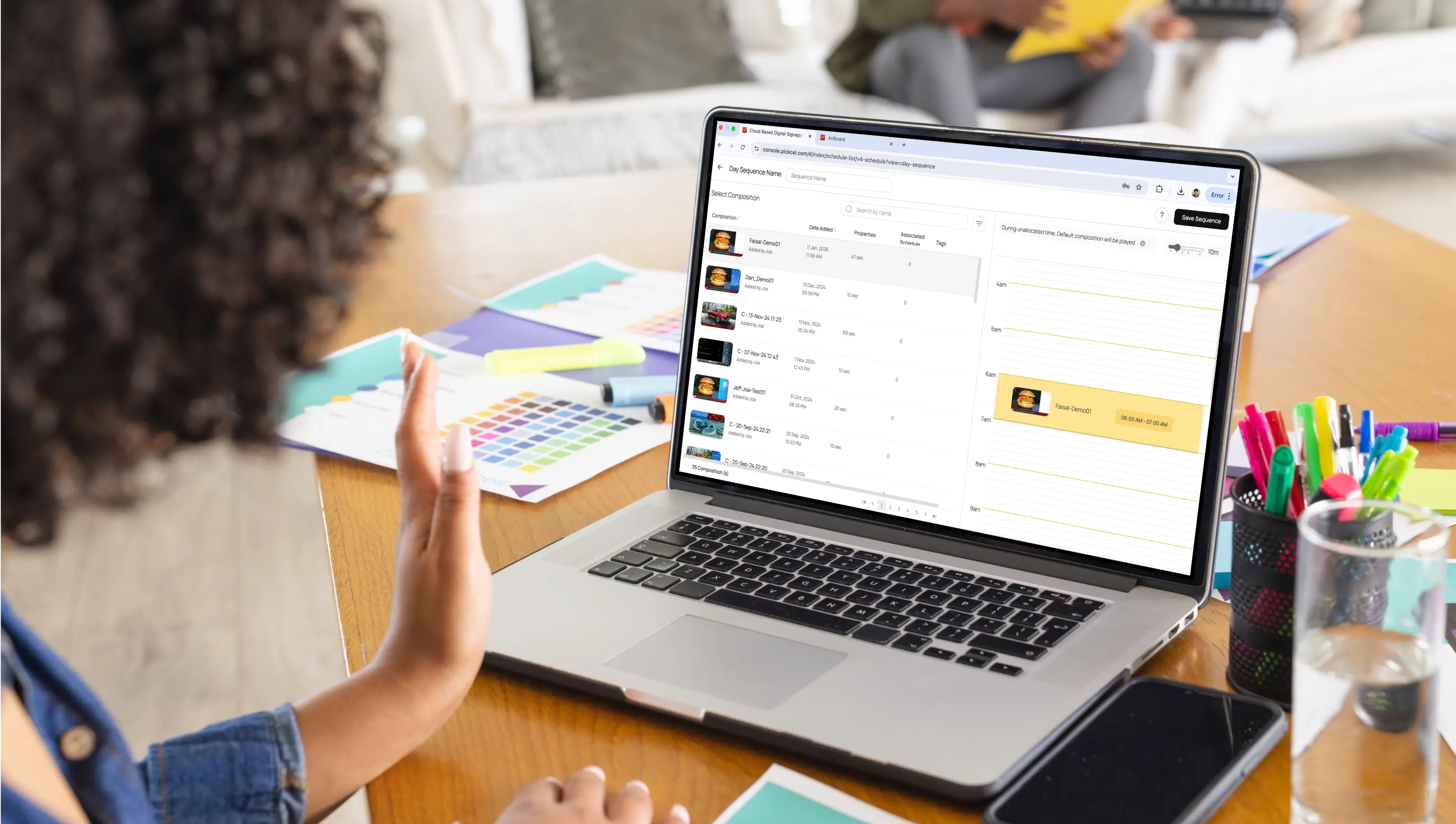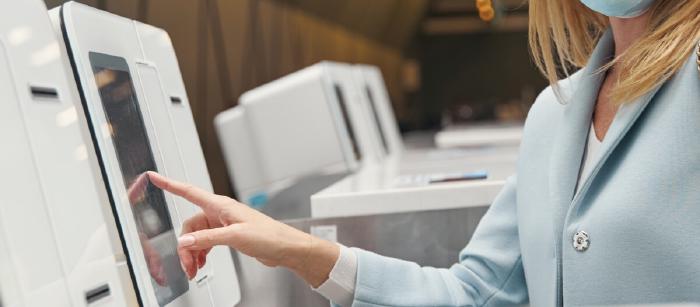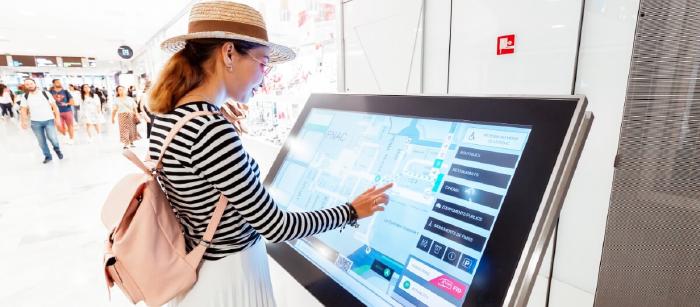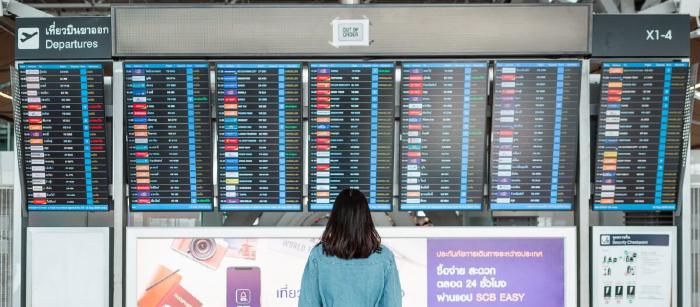![What are 3D digital billboards for advertising? [5 Examples]](/blog/images/3d-advertising-billboard/banner_hu3a52995533a2f5f6af3321531a883f0d_86539_700x0_resize_q75_box.jpg)
Sep 8 2022
6 min read

Walking down the road on a sweet, breezy morning, you are thinking about what to pick up for breakfast. You are early, and most shops haven’t had a good morning yet! Suddenly, you come to a halt seeing a giant digital billboard saying, Looking for some beans on toast or a fresh brew at 7 am? Give us a call, and we will have it at your doorstep in 10 minutes!
Bemused, you connect with the advertisement and have a hearty meal delivered in 10 mins (for real)! Congratulations, you just ended up purchasing after watching a digital-out-of-home advertisement!
Digital Out-Of-Home (DOOH) advertising involves e-displaying dynamic promotional media such as videos, animations, and brand advertisements. Simply put, DOOH refers to any digitized advertising display that can be seen on the streets or at places of public gathering, such as stadiums and malls.
DOOH has become a rage among the marketing tycoons, for its easy-to-understand operating procedure, besides its tremendous reach and control to the advertiser while catching the audience’s attention more effectively than static billboards!
A DOOH software enables advertisers to remotely control what content shows up on the screens at what time, tailor it according to the location, current weather, people frequenting it, and so much more!
Digital signage for billboards enhances advertising campaigns by delivering dynamic and targeted content to captivate audiences in real time.
But where do Digital-Out-Of-Home ads work the best? Is it only limited to the colossal billboards you see at Central Square? Let’s find out.
Book My personalized demoOver the past decade, online ad pop-ups have risen, but the click-throughs have fallen at the same rate! All thanks to ad-blockers (yeah, that ‘stop watching this ad’ option, which both you and I have often clicked on!)
Offline advertising still stands strong; especially the outdoor marketing models. With continuous breakthroughs in interactive and programmatic smart digital signage technology, digital-out-of-home advertising has snowballed. Here are some of the most popular types of DOOH that work the best!

The most prominent and probably the best example of DOOH advertising are the digital billboard signs that showcase your brand ads everywhere- from the packed-up freeways to motel rooftops. Studies indicate that 81% of users engage with brands whose billboards they come across.
Digital billboards have already stepped into the future. 3D digital billboard technology will make these large-scale outdoor advertising content pop out of the screens and almost reach out and touch the viewers at arm’s length. Since this form of experiential marketing evokes a sensational ‘wow’ in the viewers’ minds, many predict that 3D digital billboards will soon rule the advertising world.
Digital billboards make ads memorable with their bright, dynamic displays. What makes them more popular is that they’re cost-efficient and offer flexibility with enhanced targetting simultaneously.
Example IRL - Cartier’s 3D billboard advert in Hong Kong
In December 2021, Cartier developed a spectacular 3D digital out-of-home visualizer at the Hing Wai building in central Hong Kong. The advertisement opened with a giant red Cartier box on the screen, unboxing into a smaller one reading, Love is all with jingle balls popping all around, indicating it’s time for holiday season shopping! Well, this surely does have my heart
Example IRL - CVS’s #BeautyUnaltered DOOH ads in Times Square, NYC
When discussing digital billboards, Times Square in New York City is an indispensable example. With more than 380,000 people walking through every day, advertisers can get nearly 1.5 million impressions daily, plus extra buzz from social media.
CVS jumped on this with their #BeautyUnaltered campaign. They asked people to upload unedited selfies with the hashtag #BeautyUnaltered, and every 10 seconds, a new face popped up on the Times Square screens. The campaign blew up, getting over 3.6 billion impressions and boosting CVS’s brand big time. This just shows how awesome digital billboards in Times Square can be!
Some of the most engaging and futuristic ad campaigns have been experimented on bus stop DOOH displays. The reason? People are mostly unoccupied, and there is a high possibility that they would like to engage with ad campaigns to kill the boring wait time.
Moreover, bus-stop DOOH advertising is mainly seen in high-traffic urban areas, where bus stop digital signage exposes a diverse audience in a single location. They guarantee consistent visibility among commuters and pedestrians, thus enforcing a more robust brand recall and interaction.
This ability to reach a specific audience within a defined space aligns with the principles of narrowcasting, a targeted communication strategy unlike traditional broadcasting which is more generalized.
Example IRL - Pepsi Max AR DOOH screens at London bus shelter
Pepsi Max promoted its “Unbelievable” sugar-free drink by offering London commuters an out-of-the-world experience than flat-out advertising.
People waiting at the New Oxford Street bus shelter experienced a perfect handshake between the fictional world and real world through the transparent screens installed with Augmented Reality technology.
From flying UFOs to monsters consuming people on the street and gigantic flying robots shooting lasers from the eye, everything made people jump out of their seats, take pictures, and— if I am not wrong— talk about this to their friends for days to come.
Think AR is wild? there’s this cool board that zaps you to Lego land! Lego genius Nicholas “Blackbulb” Foo partnered with Ogilvy’s amazing creative team to design three epic bus stop signs: “Whale,” “Monster,” and “Caterpillar.” Unlike traditional DOOH billboards that hold attention for just 6-7 seconds, these AR-powered DOOH campaigns can engage consumers for 1-6 minutes. This extended engagement creates a memorable and shareable brand experience.
Next to billboards and car-top signs, digital out-of-home installations on the street’s sidewalks receive the highest impressions. Whether you are out jogging or rushing to catch the 9 am bus, a quick glance at a bright HD digital poster with amusing ad copy is almost inevitable.
In fact, footpath DOOHs have the fastest outreach per thousand (more than your Instagram post) and involve the lowest outdoor digital signage advertising cost - thanks to their easy mobility!
Footpath advertising offers unique benefits by providing high visibility in busy pedestrian areas, making it an effective way to capture the attention of passersby. Positioned at ground level, these ads are impossible to miss and reach people in everyday routines.
Contact USExample IRL - Emily Crisps’ digital footpath, UK

Snacking brand, Emily Crisps came up with a brilliant digital out-of-home campaign idea amidst the strictest lockdown in the UK back in April 2020. The brand, launched in December 2019, had decided on the perfect summer rollout until Covid played its card!
The creative team was quick to change their plans and turn their presumed marketing misfortune into one delivering smiles to the key workers and those who couldn’t avoid being out and about.
The digital footpath ads read “Our first ever poster, seen by a runner and one pigeon. Typical” and “Hmm… Maybe we should have made a TV ad instead”, alongside colorful images of their unique sweet potato veg sticks and the message “Eat Bold.”
Marketing on the wheels, huh? That’s right!
Your promos are no longer limited to the passengers sitting inside an Uber; you can reach out to the broadest range of viewers since these digital screens are installed on top of vehicles! Car-top DOOH signs are instrumental as they can blend technology like geo-targeting to display ads according to the time of the day and the live location of the car.
Mounted on taxis and rideshare vehicles, such ads are highly visible as they are noticed in densely populated and high-traffic areas. Another advantage of this type of DOOH signage is that you can eliminate the costs of putting out multiple location-tailored ads. They are best for geo-targeted campaigns, as they show ads based on the real-time location of the vehicle.
Example IRL - Uber’s intelligent Car-Top DOOH in the USA
In April 2020, Uber unveiled the installation of digital screens atop their vehicles that could allow drivers to earn additional revenue by running ads on two-sided, internet-connected digital billboards.
The Uber OOH network was initially launched in Atlanta, Phoenix, and Dallas with 1,000 vehicles equipped with digital screens.
In a statement released alongside this announcement, Uber stated that these displays were powered by technology that could show ads according to nearby places, tailoring according to the location the car is currently at, becoming the first of its kind to introduce mobile digital-out-of-home ads.
In 2021, the network expanded to New York and Chicago.
Most modern-day elevators at corporate tech parks, shopping malls, and hotels would house an embedded flat 15-inch screen to advertise offers from the office cafeteria or play movie trailers & ticket prices of the nearest movie theatre!
Best part? No one can skip your advertisements here― if they are inside the lift, they are bound to see it!
Elevator DOOH advertising uniquely benefits brands by delivering highly targeted, captive messaging in enclosed spaces where people are naturally inclined to pay attention. This format ensures complete, undistracted visibility, enhancing message retention and brand recall. It’s particularly effective in office buildings, hotels, and residential complexes, allowing for precise targeting of specific demographics.
Example IRL - Lasik MD’s elevator ads

In 2021, Lasik MD’s digital out-of-home advertisement series on Target’s hydraulic elevators across the US. These programmatic ads incorporated technology to identify if someone in the elevator was a candidate for Lasik surgery.
The ads could also detect the type of eyewear the riders had on and change accordingly, making it to the list of must-Google brands!
Related Article: The power of elevator digital signage: What to show and how to show?
A common sight in the USA, gas station digital advertisement boards are entirely eye-catchers. Waiting to fill up your vehicle at the pump, you glance around and see a new book store is up in the neighborhood.
As you wait to fill up your vehicle at the pump, you might glance around and notice a new bookstore in the neighborhood. Meanwhile, Netflix’s campaign highlights trending shows and movie premieres, displaying messages like “Top Series in Los Angeles” or “New Releases Near You.”
You were not expecting to come across this ad, but now you want to checkout the place - exactly what gas station screens have as an objective! Attract inadvertently and make them engage willingly!
Positioned directly at pump stations, these ads ensure high visibility and prolonged exposure, as customers typically spend several minutes at the pump. Gas station ads can leverage real-time, dynamic content tailored to location, time of day, or weather, making messages more relevant and engaging. This form of advertising also enables targeted promotions, such as discounts or offers at nearby stores, effectively driving foot traffic.
Weather-based digital ads are the ones that use real-time weather data to display targeted ads dynamically according to real-time weather changes. It’s a type of contextual advertising that aligns the ads to the immediate needs or preferences of the audience, thus adding a touch of personalization and boosting viewer engagement.
Such ads operate through conditional programming, wherein the DOOH software displays specific ads based on the criteria of weather conditions being met. For example, if the temperature rises above 85°F, the software could switch to ads for cold drinks, while a rain forecast might trigger umbrella or raincoat ads. This targeted approach helps brands reach customers at the right time and place, enhancing the ad’s effectiveness.
Example IRL - eBay’s Weather-based Billboard ads
eBay once had a weather-driven advertising campaign using this innovative approach. For instance, eBay’s digital billboards showcased ads related to raincoats, rain gears, umbrellas, and other related products when the weather turned overcast or rainy. This is how eBay used weather-based digital ads to make them contextually relevant for its audience.
Example IRL - Gas station ads across the US

Yup, I did have a hard time pinpointing one brand here!
Gas station ads across the US are perhaps the best example of dynamic DOOH. Be it a Pepsi can pop up on a kiosk beside the gas nozzle or a giant digital screen showing Burger King Ads, America has truly made effective use of digital out-of-home technology!
What’s the add-on? The ads are of places nearby, so if you want to show up after being bitten by this bug called ‘curiosity’ and jump in that water, be free!
Well, we do have a clear winner here! And for the right reasons!
Digital Out Of Home marketing has been a worldwide rage for quite some time, given its higher control of content distribution and visual appeal! Let’s discuss a few of the top benefits of DOOH advertising.
Real-time updates: With the world at everyone’s fingertips, billboards need to update in moments! Imagine a monsoon sale advert showing up at the end of the autumn! Certainly not desirable! Is it summer? How about a fickle 20% discount on all your DOOH screens in minutes (nope, not deploying people to take days and change that creaky billboard)?
More extensive outreach: Perhaps, I have been saying it throughout the blog. Digital outdoor signs can grab many eyeballs and get them to Google up your business or drop in at your store more than any traditional advertisement would.
Higher interaction: The tech boom has revolutionized DOOH ads, turning them into interactive experiences rather than just one-way communications. Interactive, gamified ad campaigns that offer rewards are now exciting audiences and boosting brand recall. Brands can use DOOH to encourage user-generated content (UGC). For instance, Cadbury launched a competition inviting the British public to create their own Dairy Milk flavor, with the top three entries being showcased through dynamic DOOH ads.
Analytics: One of the critical benefits of digital out-of-home displays over traditional ones is that these generate viewership analytics, similar to online ads, proving extremely handy to marketers and network operators. It offers data such as proof-of-play, number of impressions, or any data which allows the brand to understand consumer psychology and plan their future campaigns with data-backed insights.
While these advantages firmly establish DOOH as a powerful medium, its true potential is only seen through a strategic approach such as campaign-based publishing. This method takes these inherent benefits – like real-time updates, audience engagement, and robust analytics – and orchestrates them into cohesive, measurable campaigns designed for specific objectives, moving beyond just displaying individual ads to crafting a full narrative that maximizes impact and ROI.
Are you seeking a reliable digital signage partner to kickstart your DOOH advertising? If so, Pickcel is the right partner for you. Pickcel’s DOOH advertising solutions stand out with their industry expertise alongside their impactful and targeted campaigns, making your audience feel like the ads are personalized just for them.
With a user-friendly platform and a reliable support team, Pickcel’s digital signage software helps you take charge of your content with remote management features. You can schedule, manage, publish, and adjust your campaign and content anywhere.
Furthermore, their data-triggered campaigns quickly adapt to local conditions and audience demographics, helping you run hyper-targeted ads. Irrespective of whether it’s a public announcement or storefront promotion, Pickcel’s DOOH advertising solution is tailored to meet your needs. With 60+ app integrations, including weather, news, RSS feeds, and others, it seamlessly integrates into your existing setup with minimal additional hardware investments.
Once you’re with Pickcel, their detailed analytics with real-time data will help you gauge your campaign’s performance and optimize your ad strategies. The best part is it’s flexible and scalable. You can start with one screen and scale up to 100 without hassle.
With Pickcel, you’re not alone. Their expert support team provides dedicated assistance to ensure your campaigns run smoothly, offering insights and recommendations that help you maximize your DOOH advertising.
Digital out-of-home advertising has made life easier for consumers and businesses alike. Delivery of personalized digital ads in a world of traditional offline billboards was never possible earlier. But, with e-signage becoming increasingly relevant, what might have sounded like a distant daydream has turned into a living reality! Technology is empowering the advertising world, and it’s time to say hello to a life we could only imagine in Sci-Fi books!




![What are 3D digital billboards for advertising? [5 Examples]](/blog/images/3d-advertising-billboard/banner_hu3a52995533a2f5f6af3321531a883f0d_86539_700x0_resize_q75_box.jpg)
Sep 8 2022
6 min read

Jul 15 2022
11 min read

Jul 15 2022
12 min read

May 23 2022
7 min read
Take complete control of what you show on your digital signage & how you show it.
Start Free Trial Schedule My Demo